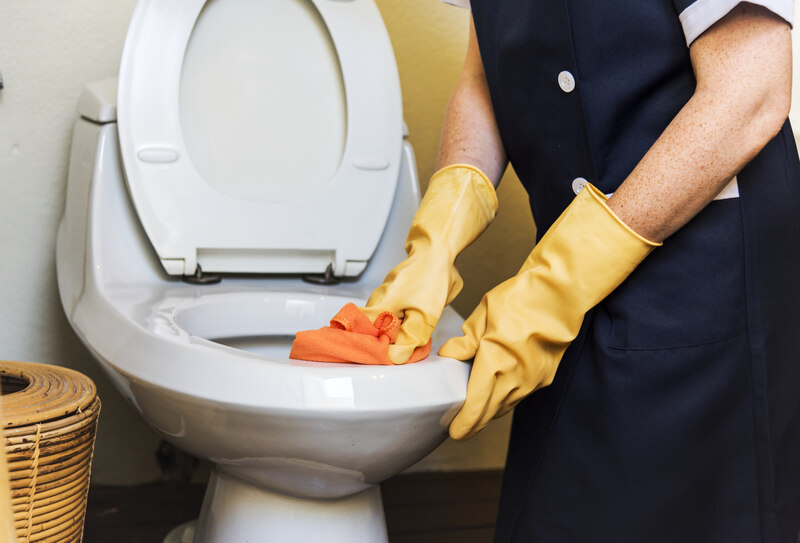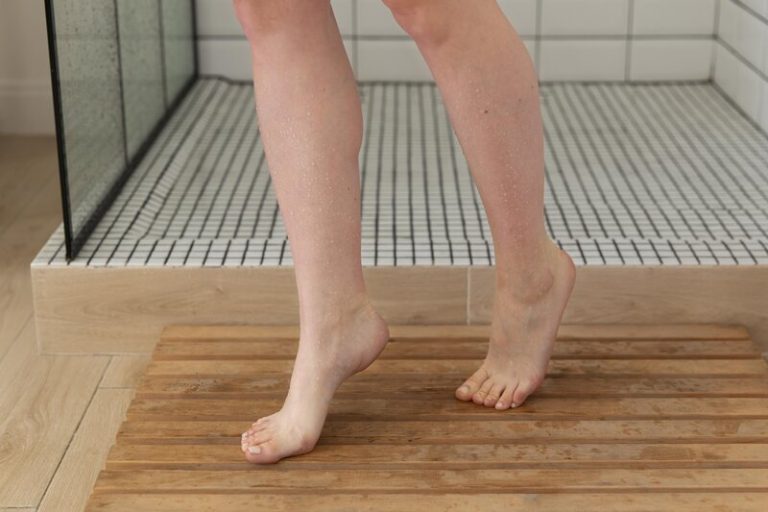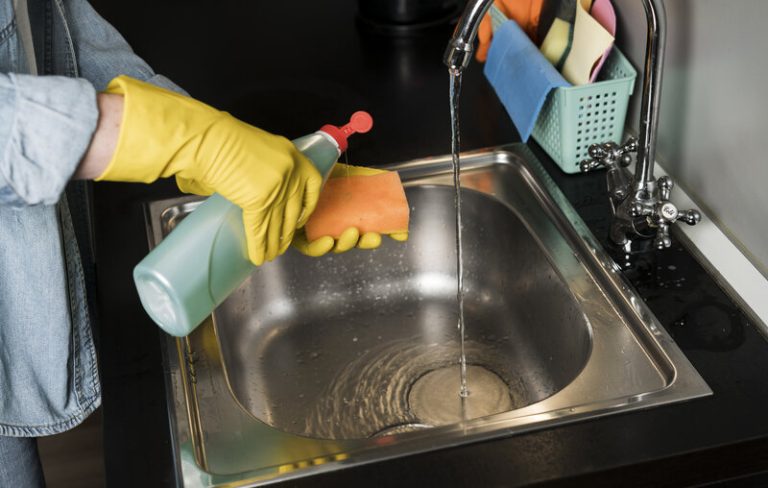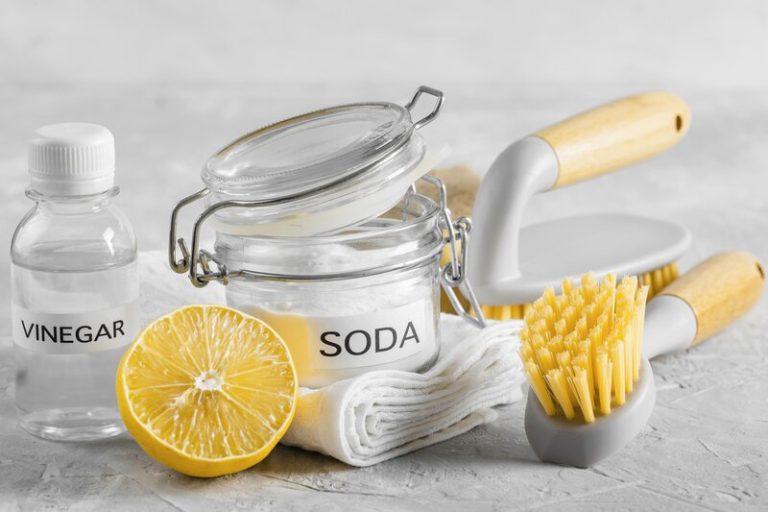Is your toilet plagued by stubborn limescale build-up? If so, it’s time to know how to remove limescale from a toilet bowl. Understanding what limescale is, how it forms, and why it’s important to remove it can help you maintain a clean and hygienic bathroom.
We will cover how to remove limescale from toilets, including using vinegar and baking soda, commercial lime scale removers, and pumice. We will also discuss precautions to take, how often to remove limescale, tips for prevention, and whether limescale can impact your health.
Let’s dive into how to remove limescale from toilet bowl and tackle this common household nuisance together!
What Is Limescale?
Before we dive into how to remove limescale from a toilet, make sure you know what limescale is.
Limescale, also known as calcium carbonate, is a hard, chalky deposit that forms on surfaces where hard water has evaporated. It is commonly found in areas with high mineral content in the water supply.
This mineral build-up occurs when water containing high levels of minerals such as calcium and magnesium evaporates, leaving behind these deposits. As the water evaporates, the minerals in the water solidify and adhere to surfaces, creating hard, crusty limescale deposits.
These deposits can be unsightly, often appearing as white or off-white and can feel rough to the touch. Common areas where limescale accumulates include taps, shower heads, sinks, and kettle heating elements, as these are frequently exposed to hard water.
Regular cleaning and descaling are essential to prevent the build-up of limescale and maintain the efficiency of appliances.
How Does Limescale Form in Toilets?
Limescale forms in toilets due to the presence of hard water, which contains high mineral content. When hard water evaporates, it leaves behind mineral deposits that accumulate over time, resulting in stubborn stains on toilet surfaces.
The Importance of Removing Limescale from Toilets
It is essential to remove limescale from toilets to maintain cleanliness, prevent bacterial growth, and prolong the lifespan of bathroom fixtures. Regular cleaning tasks, including limescale removal, are crucial for hygiene and aesthetics.
Limescale build-up not only affects the visual appeal of your bathroom but can also lead to the accumulation of harmful germs and bacteria, posing health risks to you and your family members. Proper maintenance and limescale removal plays a significant role in ensuring a sanitary environment and preventing unpleasant odours in your restroom. By incorporating simple cleaning routines, you can uphold a sparkling toilet that promotes overall well-being and adds to the overall cleanliness of your living space.
Different Methods to Remove Limescale from Toilets
When asking how to remove limescale from toilets, there are basically a variety of methods that can be employed, including using natural ingredients such as vinegar and bicarbonate of soda, commercial lime scale removers, and the abrasive action of pumice stones to effectively tackle stubborn deposits.
In terms of limescale removal, vinegar is a popular option due to its acidic nature that helps dissolve the mineral buildup. You can easily create a vinegar solution by mixing equal parts of water and vinegar, applying it to the affected areas, and letting it sit for a while before scrubbing. Bicarbonate of soda, on the other hand, acts as a gentle abrasive cleaner that can be used in combination with vinegar for added effectiveness.
- Commercial limescale removers, available in various formulations, offer a quick and convenient solution to tackle severe limescale deposits.
- For tougher stains, the abrasive power of a pumice stone can be employed by gently scrubbing the affected areas to remove stubborn buildup without causing damage.
a. Using Vinegar and Baking Soda
One effective method to remove limescale from toilets involves using a mixture of vinegar and baking soda. White vinegar’s acidic properties help dissolve the limescale while baking soda acts as a gentle abrasive to scrub away the deposits.
To apply this method, start by pouring a cup of white vinegar into the toilet bowl, ensuring it covers the limescale stains. Allow it to sit for at least 30 minutes to loosen the deposits. Next, sprinkle baking soda around the bowl, focusing on areas with stubborn limescale build-up. Use a toilet brush to scrub the mixture into the stains, working from top to bottom. Rinse the bowl thoroughly with water to reveal a sparkling clean surface.
Using natural cleaning agents like vinegar and baking soda not only effectively removes limescale but also reduces the need for harsh chemicals. This eco-friendly approach also helps maintain the longevity of your plumbing system while being safe for the environment.
b. Using Commercial Limescale Removers
Commercial limescale removers offer a convenient solution for tackling stubborn limescale deposits in toilets. These products contain specific chemicals that effectively break down the mineral build-up, making cleaning tasks more manageable.
One important aspect to note when using commercial limescale removers is to follow the manufacturer’s instructions diligently to ensure safety and optimal results. Protective gear such as gloves and goggles are often recommended due to the potent nature of the chemicals involved in these products. It is advisable to ventilate the area well when applying these removers to prevent inhaling fumes. Applying the remover directly to the affected areas and allowing it to sit for the recommended time before scrubbing can enhance its effectiveness.
c. Using a Pumice Stone
A pumice stone can be used to remove tough limescale stains from toilet surfaces with the application of elbow grease. The abrasive nature of the pumice stone helps scrub away the deposits without damaging the toilet bowl.
When using a pumice stone for limescale removal, it is essential to wet both the stone and the surface before scrubbing. This reduces the risk of scratching or causing any damage. A gentle yet firm pressure is recommended to effectively tackle stubborn limescale.
Regular maintenance with a pumice stone can prevent the build-up of limescale over time, maintaining a sparkling toilet surface. The versatility of pumice stones also extends to other surfaces like sinks, showers, and even kitchen appliances, making them a handy and eco-friendly cleaning tool.
What Precautions Should You Take When Removing Limescale?
When removing limescale from toilets, it is important to take necessary precautions such as wearing protective gear like gloves and goggles to prevent skin irritation and eye exposure. Ensure proper ventilation in the area to avoid inhaling cleaning fumes.
Another vital safety measure during limescale removal is to use a non-abrasive cleaner to prevent damage to the toilet surface while effectively removing the buildup. It is also recommended to
- follow the manufacturer’s guidelines
- when using cleaning products to prevent any adverse reactions
In addition, do not mix chemicals as they can lead to dangerous reactions and always flush the area with water after cleaning to ensure all residues are removed and the area is safe for use.
a. Wearing Protective Gear
Wearing protective gear, such as gloves and goggles, is essential when dealing with limescale removal to prevent skin contact with harsh chemicals and ensure personal safety during cleaning tasks.
The use of protective gear not only shields your skin from potential hazards but also helps safeguard your eyes and respiratory system from airborne particles released during the cleaning process. Gloves provide a barrier against abrasive substances while goggles protect your eyes from splashes and fumes. Wearing a mask can prevent inhalation of harmful vapours. By donning the appropriate protective gear, you significantly reduce the risk of accidents and chemical burns, promoting a safe and secure cleaning environment.
b. Ventilating the Area
Properly ventilating the area during limescale removal is crucial to minimise exposure to cleaning fumes and ensure adequate airflow for a safe and comfortable cleaning environment.
When tackling limescale buildup, it’s essential to open windows, use fans, or employ exhaust systems to maintain fresh air circulation throughout the space. This not only helps in dissipating any harsh chemical odours but also prevents the accumulation of any potentially harmful vapours. Proper ventilation significantly reduces the risk of respiratory irritation and dizziness that can result from prolonged exposure to cleaning agents. Ensuring good airflow also aids in quickening the drying process after cleaning, promoting a faster and more effective limescale removal.
How Often Should You Remove Limescale from Your Toilet?
After knowing how to remove limescale from the toilet bowl in various methods, you might also be curious about how often this activity should be done.
It is recommended to remove limescale from your toilet regularly to prevent build-up and maintain cleanliness. The frequency of limescale removal depends on the hardness of the water in the given area and the usage of the toilet.
Hard water, which contains high levels of minerals like calcium and magnesium, tends to result in faster limescale accumulation. Therefore, in areas with very hard water, more frequent cleaning may be necessary to combat stubborn limescale deposits. Factors like the type of toilet bowl material, cleaning products used, and even the temperature of the water can also influence how quickly limescale builds up.
Tips to Prevent Limescale Buildup in Toilets
To prevent limescale buildup in toilets, consider implementing tips such as regular cleaning routines, using a water softener to reduce the mineral content in water, and installing a limescale prevention system to maintain toilet hygiene effectively.
Limescale can be a common nuisance in toilets, especially in areas with hard water. Apart from cleaning strategies and water treatments, another preventive measure is to ensure proper ventilation in the bathroom to reduce moisture build-up, which can contribute to limescale formation. Using vinegar or lemon juice for spot cleaning can help dissolve limescale deposits naturally. Regularly checking and fixing any leaks in the toilet system can also prevent excess water exposure that promotes limescale growth. By incorporating these measures, you can significantly reduce limescale issues in your toilet.
a. Regular Cleaning
Regular cleaning of the toilet bowl is key to preventing limescale build-up and maintaining a hygienic bathroom environment.
By establishing a consistent cleaning schedule, you can stay ahead of limescale accumulation and ensure the toilet remains sparkling clean. Using vinegar or lemon juice can be an effective natural alternative for dealing with limescale deposits. Investing in a good quality toilet brush and cleaner specific for limescale removal can make the cleaning process more efficient.
b. Using a Water Softener
Installing a water softener can help reduce the mineral content in hard water, thereby preventing limescale build-up in toilets and other fixtures.
Softened water is gentler on surfaces and less likely to leave stubborn deposits.
Water softeners work by using an ion exchange process to replace calcium and magnesium ions with sodium ions, making the water softer and more manageable for everyday use. This not only benefits the aesthetics of your bathroom fixtures but also extends the lifespan of your plumbing systems by reducing the risk of blockages and corrosion caused by mineral accumulation.
When considering the installation of a water softener, it’s essential to assess your household’s water usage and choose the right size and type of softener to meet your specific needs. Regular maintenance and proper regeneration of the softening system are crucial to ensure its continued effectiveness in combating limescale and maintaining water quality.
c. Installing a Limescale Prevention System
A limescale prevention system can be a proactive solution to combat limescale deposits in toilets by treating water before it enters the plumbing system. These systems help minimise mineral buildup and reduce the need for frequent cleaning.
There are different types of limescale prevention systems available, such as electronic descalers, water softeners, and descaling solutions, each offering unique advantages.
Installation of these systems is typically straightforward and can be done by following the manufacturer’s instructions or with the help of a professional plumber, ensuring optimal functionality.
The effectiveness of limescale prevention systems lies in their ability to break down minerals in the water, preventing them from forming stubborn deposits on toilet surfaces, which in turn, maintains the cleanliness and extends the lifespan of the plumbing fixtures.
Can Limescale Affect Your Health?
Limescale itself is not known to pose direct health risks to individuals, but its presence can indicate the need for thorough cleaning and maintenance in the home environment. Regular removal of limescale can help maintain hygiene standards and prevent bacterial growth.
Whilst limescale may not be harmful on its own, it can lead to the build-up of bacteria and other pathogens if left unchecked.
Keeping surfaces free from limescale is crucial to ensure a clean and healthy living space. Incorporating proper cleaning practices, such as using vinegar or specialised limescale removal products, can help in maintaining a germ-free environment.
Limescale deposits can affect the efficiency of appliances like kettles and showerheads, potentially leading to increased energy consumption and reduced performance levels over time.
Thus, staying proactive in addressing limescale issues is essential for both health and household upkeep.
Final Thoughts
Understanding how to remove limescale from a toilet is essential for maintaining a clean and hygienic bathroom environment. By implementing the right cleaning methods and preventive measures, you can tackle limescale buildup and ensure the longevity of your fixtures.
Limescale is a common issue in many households, especially in areas with hard water. It not only impacts the aesthetic appeal of your bathroom fixtures but can also lead to plumbing problems if left unaddressed.
Using appropriate solutions and methods to deal with limescale is crucial in preventing damage and preserving the functionality of your toilets. Regular cleaning with vinegar or citric acid can help dissolve limescale deposits, while also being environmentally friendly.
However, for those hard-to-tackle areas or if you simply don’t have the time to keep up with the demanding task of keeping your bathroom limescale-free, TEKA Cleaning is here to help.
Let TEKA Cleaning be the solution to your limescale woes. Our experienced team doesn’t just stop at surface cleaning, we delve deep to remove all signs of limescale, ensuring your toilets and bathroom fixtures shine like new.
With our expertise and use of professional-grade, environmentally friendly cleaning solutions, we provide a thorough clean that not only tackles limescale but also preserves the longevity of your bathroom fixtures.
Don’t let limescale take over your bathroom. Book now or give us a call at 01233 751 544 to schedule your house cleaning with TEKA Cleaning. Let us take that one last thing off your list, so you can come home to a sparkling clean bathroom without lifting a finger.
With TEKA Cleaning, you’re not just getting a clean home, you’re reclaiming your time to enjoy the moments that matter most.
Read also:











